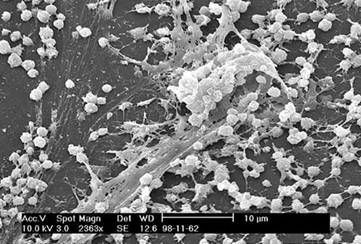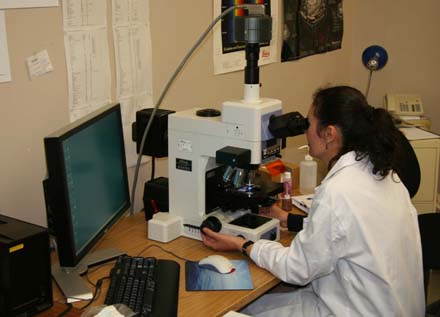Advances in Microscopy
Of course, technology supporting scientific investigation has advanced tremendously since the days of van Leewenhoek. Just consider microscopy. Recall that van Leewenhoek was known for producing the most effective microscopes of his time, allowing him to view microscopic life as no one else hitherto. The more one can observe, the more one can understand.
How far have we come since the days of van Leewenhoek? How much more can we see?
What You See is What You Get—Microscopy and Computers
The following movie, constructed with the help of computer software, is from a series of still images recorded through a microscope. It illustrates what can be done with modern microscopes coupled with computer programs that can create movies from stil images. This movie demonstrates some biofilm colonies form in such a manner that channels exist throughtout the biofilm. That these channels are open and in fact function as conduits which can deliver oxygen and nutrients deep within the biofilm is shown by this video clip (Video 1).
In this movie, biofilm has been grown in a flow cell with the builk fluid flowing from right to left. The particles are fluorecent spheres approximately 5 Um in diameter. Their rapid movement indicates that the deep channels in the biofilm are in contact with the bulk fluid layer many micrometers above.
Brightfield and Electron Microscopy
In the 1970s and 80s options for viewing biofilms were chiefly brightfield and electron microscopy (EM-Chap 8) (See exercise entitled: Flow Through Gram Stain). The use of each of these instruments requires the subject to be dehydrated and typically stained (Molecular probes - Chapter 8). The optical resolution of a brightfield microscope (about 0.25 µm) is too small to reveal much detail and although the detail seen under electron microscopy was magnificent, it was misleading. Eighty five to ninety five percent of a biofilm consists of water; the rest is cells, inorganics, and various polymeric materials that are often quite fibrous in nature. The removal of the water, necessary in electron microscopy, results in an image of bacterial cells lying within a flat matrix of fibers. Trying to intuit the nature of a biofilm from electron micrographs is roughly equivalent to deducing the nature of an animal from a long dead road kill.
Confocal Microscopy

Perhaps the single most significant change that permitted a more realistic view of biofilm structure was the application of confocal microscopy (Confocal Microscopy - Chapter 8). Confocal microscopy is a combination of laser technology and computerimage processing software that permits the observation of a wet subject on virtually any sort of surface without the need to dry it first.
In confocal microscopy, the illuminating radiation is laser light (at left), which passes thorough a pinhole before striking a half silvered or dichroic mirror. The light then passes down through the objective and illuminates the object of interest. If the object is stained with a fluorescent dye, or perhaps contains natural pigments or other materials that fluoresce, it will emit light of a somewhat longer wavelength, which then passes back into the objective lens, and through the dichroic mirror. Now comes the tricky point, which makes the confocal microscope such a useful tool for biofilm research. Notice in the diagram that fluorescent light is being produced at different layers within the object (indicated here by rays colored blue, red and green). If all of this light were to enter the eye of the observer or the photoreceptor tube, the image would be blurry because of the great depth of field from which the light is emanating. But also notice that in this microscope there is a second pinhole. Only light from a very specific depth within the object may enter the pinhole and be "seen" by the phototube. Light from a greater or lesser depth strikes the light stop and is not seen by the phototube. In effect we have a view of an optical slice of the object, which can be recorded as a digital image. By simply moving the objective up or down, a small but very precise distance, we can get another slice and so on. We are essentially sectioning the object optically much as a technician takes a CAT scan or a butcher slices baloney at the meat market. With the aid of a computer we can reassemble these individual images to build an optical reconstruction of the original object. Furthermore the computer can turn the reconstructed image on its side so we can see not only length and width as in a typical microscope but depth as well. We refer to these as x-y and x-z images. With these images we can see what no one had previously observed (See exercise entitled: Building a Biofilm Model from a Confocal Microscope Stack).




